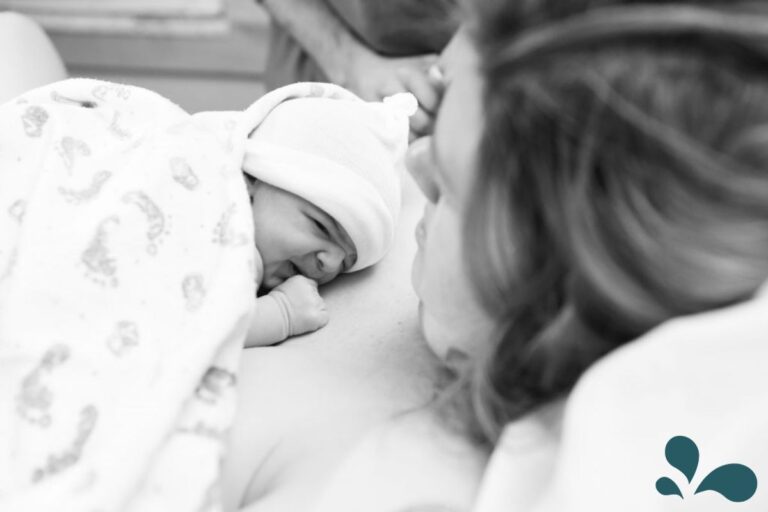When breastfeeding, it can be challenging to know when or how to offer a bottle. Will my baby prefer the bottle?
Paced bottle feedings make bottle feeding more similar to breastfeeding and help baby to be able to go back and forth if that is your desire.
In addition to knowing about paced bottle feeding, you’ll need to teach anyone who will be caring for your baby (for a single feeding or longer) about paced bottle feeding, as well.

What is Paced Bottle Feeding?
Paced bottle feeding has several key attributes.
It mimics breastfeeding by allowing the baby to remain in control, and finally, paced bottle feeding slows/paces the feeding so that baby can tell when they are full and not overeat. The chief idea is that it’s a slower pace and allows baby to suck and continue at their speed, rather than gravity pulling milk into baby’s mouth potentially faster than baby prefers or is used to when feeding.
How to do Paced Bottle Feeding?
Step one: your baby needs to be sitting upright.
Step two: bring the bottle up to baby’s upper lip.
Step three: allow baby to pull the bottle into the mouth.
Step four: check that baby’s lips flare around the nipple base.
Step five: hold the bottle horizontal (always make sure there is milk in the tip of the nipple, so baby is not sucking in air).
Step six: every 20-30 seconds, tip the bottle down for baby to take a break.
Step seven: repeat.
Step eight: remove the bottle when baby starts showing signs of fullness.
Note: halfway through the bottle, burp baby, switch the side baby is sitting on, and repeat the above steps. This action mimics the breastfeeding experience. This video is a great resource to watch how to follow these steps.

Why is each step important?
Baby Position
Positioning your baby in an upright position will help baby control the flow of milk. This position goes back to how lying down with a bottle makes it so gravity drips the milk straight into baby’s mouth at a pace with less control. Baby doesn’t need to be sitting at a 90-degree angle; however, baby does need to be mostly upright (even if baby is sitting in a slanted position).
Baby can also be placed on their side on your lap (very similar to how they would feed at the breast). This position also allows them to control the flow of milk from the bottle.
Horizontal Bottle
When you do this, you’re placing the nipple over the baby’s lip (nipple flush against the skin and slanted up toward the nose). This is important because it mimics when the baby is put to the breast. You’ll wait until baby starts rooting at the bottle nipple (just like a breast) and then allow the baby to take the nipple into their mouth.
At this point and until the end of the feeding, keep the bottle horizontal (don’t tilt it up). This helps the feeding last 10-20 minutes (like a typical breastfeeding session), rather than five to eight minutes like a typical bottle feeding. This slower pace allows baby’s stomach to communicate to the brain when baby’s stomach is full.
Switching sides
Halfway through the feeding (when the bottle is half empty), move baby from one side of your body to the other. Switching sides alters baby’s view and eye contact while preventing baby from developing a side preference.
Ending the feeding
Now, with paced feeding, the feeding doesn’t necessarily end when the bottle is empty. The feeding is over when baby’s eyes start wandering, sucks slower, falls asleep, and/or hands are open and relaxed.
If you see these signs, try gently removing the bottle from baby’s mouth. After removing it, offer it again. If baby accepts the bottle, give baby several sucks and try removing it again. Do this repeatedly until baby refuses the bottle.
This final step is important because this helps baby recognize fullness, which is an important life skill that will carry for years to come, but also it helps prevent colic and spitting up.
Benefits of paced bottle feeding
There are several benefits to paced bottle feeding.
- Helps baby avoid over or under eating
- Places less stress on baby
- Helps baby avoid swallowing air (and subsequently avoiding spit-up)
- Makes pumping easier for mom
- Supports breastfeeding
Though paced bottle feeding may take some getting used to if you haven’t used this method before, it most certainly is worth it.

The Best Bottle for Breastfed Babies
My advice on this is likely not the advice you’d expect: the best bottle to use is the one that your baby will take. However, in terms of nipples, I do have a couple of suggestions.
My recommendations for bottle nipples include:
- Go for slow flow (0 flow, “newborn” or “preemie” flow nipple). Although, the actual flow amount varies between every bottle nipple and every brand.
- Find a nipple that gradually slopes, increasing in size to the base. Lansinoh, Motif, Joovy (not pictured), Dr. Brown’s Original Narrow, and Evenflo Balance Standard are all great examples of this form of nipple.
There is no shame in trying out a variety of bottles and nipples. Find what works best for your baby. There is no single answer.








